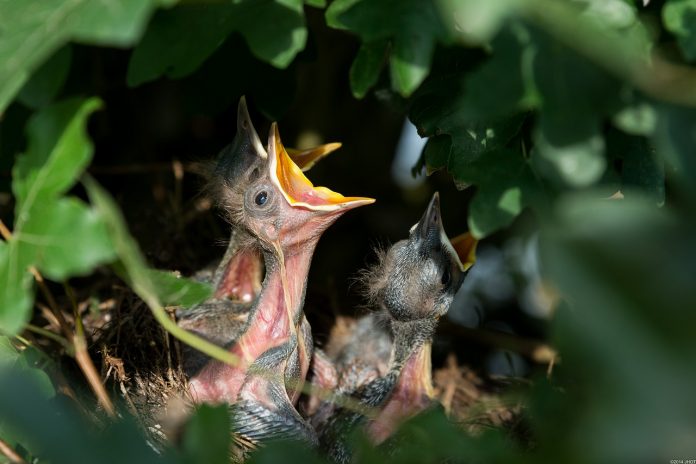Saturday marks the first official day of spring — I can’t wait. Spring means warmer weather, sunnier days, the first signs of green plant life and early blooms. Spring is also a time when many animals reproduce, which means the familiar hunger cries of baby birds are not far off.
Soon we’ll be able to observe bird pairs carefully constructing nests to lay eggs in and rear their young. And while these nests are exquisitely constructed are typically stable, spring is also known to be a season of storms.
Occasionally, a baby bird will fall, leap or be pushed out of its nest. Sometimes they will require help and others they won’t. It’s important to determine when to help baby birds and how to properly return them to their nest to give them their best chance for survival.
Should you help the baby bird?
Many baby birds that appear to be in trouble may not need any assistance. It’s more likely they are doing exactly what they are supposed to for their current stage of development.
When fledglings begin the process of learning to fly, they leap or are pushed out of their nest. Many species of birds don’t return to their nest once they are out of it. Instead, they spend several days on the ground testing their wings. These birds don’t need to be rescued and should be left alone.
In most cases, baby birds don’t need rescuing, but there are instances where they are injured, orphaned or fell out of their nest before they were ready. Here are some scenarios that warrant rescuing a baby bird:
- Its parents died.
- The nest has been left alone for at least an hour without its parents returning.
- The bird feels cold or appears lethargic or sick.
- The bird is a hatchling that may have fallen from or with his nest.
- The bird sustained an injury.
- The bird is infested with flies, maggots or other insects.
- The bird is in imminent danger from a predator.
Once you’ve decided the baby bird is in need of help, the next thing you need to do is determine the best way to help.
Helping a baby bird on the ground
Occasionally, a baby bird will fall from its nest after being pushed by a sibling or a strong wind during a storm. In these instances, it’s ok to help it back into its nest or if its next has fallen, too, replace the nest and place the bird or bird back inside.
When you discover a baby bird that has fallen, the first thing that you should do is make sure it is still warm to the touch. Baby birds have a hard time maintaining their body temperature and may have to be warmed up before being placed back in the nest.
If the baby bird feels cold, you can warm it before putting it back in the nest by cupping your hands around it. When it feels warms to the touch, you can return it to the nest as long as it’s not extremely lethargic or weak.
Have you ever been told a bird will reject a baby that’s been handled by humans? This is a myth. Birds have a poor sense of smell with the exception of vultures. Most bird parents will not reject their young just because it’s been handled by a human.
After you’ve warmed the baby bird back up, you’ll need to locate its nest and put it back. You can continue to keep the baby bird warm while you locate/adjust the nest by filling a water bottle with warm water and placing it on top of it.
- If the nest is in its original location — carefully put the baby bird back into its nest.
- If the nest was tipped askew — adjust the nest so that it is right-side-up and tie both the nest and the branch it’s on to other branches with heavy twine or wire. Don’t use sting because birds can become tangled in string. Then replace the baby bird in the nest.
- If the nest has been knocked down — pick up the nest and put it back in the tree in its original position or as close to it as possible. Next, secure it with twine or wire and return the baby bird to its nest.
- If the nest was destroyed — make a substitute nest. Use a plastic berry basket and form a nest inside with dry leaves and grass — do not use fresh grass or hay for nesting material as both contain mold and mildew that can cause respiratory problems. The cupped shape is essential to support nestlings, so make sure the center is cupped. You can also use a small plastic butter container, but make sure to poke drainage holes in the bottom. After constructing the new nest, use wire or twine to attach it to the tree as close to the original nest location as possible. Then put the hatchling in the new nest. This is also a suitable option if you are unable to reach the baby bird’s original nest. Never use old nests instead of constructing a new one when you can’t recover the baby bird’s original nest because they contain parasites and insect infestations.
Monitoring a baby bird after returning it to its nest
After replacing the baby bird in its nest monitor it to make sure the parents return. In cases where you had to make a new nest, you’ll notice the parents flying between the original and new nest. If the parents haven’t returned an hour after replacing the baby bird or if they aren’t returning every 15 minutes to feed the baby bird, they have rejected your reuniting efforts and abandoned the nest. You’ll need to take care of the baby bird or baby birds until you locate a wildlife rehabilitator for their long-term care.











